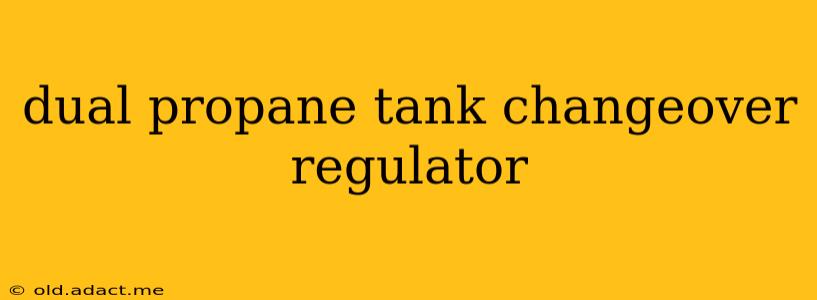Choosing the right dual propane tank changeover regulator is crucial for ensuring a continuous supply of propane for your RV, grill, or other propane-powered appliances. This comprehensive guide will walk you through everything you need to know, answering common questions and helping you make an informed decision.
What is a Dual Propane Tank Changeover Regulator?
A dual propane tank changeover regulator is a device that allows you to seamlessly switch between two propane tanks. This prevents interruptions in your propane supply when one tank runs empty. It automatically switches to the second tank, ensuring uninterrupted operation of your appliances. This is especially important for applications where a propane interruption could be inconvenient or even dangerous.
How Does a Dual Propane Tank Changeover Regulator Work?
The regulator has two inlets, one for each propane tank. It also has an outlet that connects to your appliances. Inside, a mechanism monitors the pressure in each tank. When the first tank's pressure drops below a certain threshold, the regulator automatically switches to the second tank. This transition is typically seamless, providing continuous gas flow.
What are the Different Types of Dual Propane Tank Changeover Regulators?
Several types are available, differing mainly in their pressure output and features:
- Standard Regulators: These offer a consistent output pressure suitable for most appliances.
- High-Pressure Regulators: Designed for applications requiring higher pressure, such as certain types of heating systems.
- Manual Changeover Regulators: These require you to manually switch between tanks. While less expensive, they lack the automatic switching feature.
- Automatic Changeover Regulators: These automatically switch to the second tank when the first one is empty, providing uninterrupted service.
What Size Regulator Do I Need?
The size of the regulator you need depends on the BTU (British Thermal Unit) requirements of your appliances. Check your appliance manuals for BTU ratings and select a regulator with a sufficient capacity. Oversizing is generally better than undersizing, as it provides a safety margin.
How Do I Install a Dual Propane Tank Changeover Regulator?
Installation typically involves connecting the regulator to the tanks using appropriate hoses and fittings. It is crucial to follow the manufacturer's instructions precisely. If you are uncomfortable with the installation process, consult a qualified propane professional. Improper installation can lead to gas leaks and potential hazards.
What are the safety precautions for installing a dual propane tank changeover regulator?
Always turn off the gas supply to the tanks before beginning any installation or maintenance. Use leak detection solution to check for leaks after installation. Ensure all connections are tight and secure. Never work with propane near an open flame or ignition source. Familiarize yourself with the regulator's operation and safety instructions before use.
How often should I inspect my dual propane tank changeover regulator?
Regular inspection is crucial for safe operation. Check for leaks regularly using leak detection solution. Inspect hoses for cracks, damage, or kinks. Refer to the manufacturer's recommended inspection schedule.
Can I use a single-stage regulator with two tanks?
No, a single-stage regulator is designed for a single tank. Using it with two tanks can be dangerous and may not function properly. A dual-tank changeover regulator is essential for safe and efficient operation with two tanks.
How do I troubleshoot a dual propane tank changeover regulator that isn't working?
First, check for leaks using leak detection solution. Ensure the tanks are properly filled and turned on. Check the connections to the regulator and appliances. If the problem persists, consult a qualified propane professional.
By following this guide and taking necessary safety precautions, you can ensure the safe and reliable operation of your propane system using a dual propane tank changeover regulator. Remember to always prioritize safety and consult a professional if you are unsure about any aspect of installation or maintenance.
